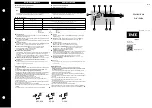
⎯
35
⎯
6
F
2
S
0
8
3
5
If the CT secondary ratings at the local and remote terminals are different, relay model suitable
for the CT secondary rating is used at each terminal and then CT ratio matching can be applied
the same as above. The differential element settings are respectively set to the setting values so
that the primary fault detecting current is the same value at all terminals. Figure 2.2.13.2 shows
an example of CT ratio matching. The settings for DIFI2, DIFGI, DIFSV and DIFC should also
be set with relation to the primary current in the same manner of the DIFI1 setting.
CT ratio : 2000/1A
Terminal-A
Terminal-B
GRL100
1A rated model
DIFI1=800A / CT ratio(2000/1A)
= 0.4A
CT ratio : 2000/5A
DIFI1=800A / CT ratio(2000/5A)
= 2.0A
Primary sensitivity = 800A
GRL100
5A rated model
Figure 2.2.13.2 Example of CT Ratio Matching incase of Different CT secondary Rating
Setting of DIFI1
The setting of DIFI1 is determined from the minimum internal fault current to operate and the
maximum erroneous differential current (mainly the internal charging current) during normal
service condition not to operate.
DIFI1 should therefore be set to satisfy the following equation:
K
⋅
Ic
<
DIFI1
<
If / K
where,
K:
Setting margin (K = 1.2 to 1.5)
Ic: Internal charging current
If: Minimum internal fault current
For the GRL100 provided with the charging current compensation, the condition related to the
charging current can be neglected.
The setting value of DIFI1 must be identical at all terminals. If the terminals have different CT
ratios, then the settings for DIFI1 must be selected such that the primary settings are identical.
Setting of DIFI2
The setting of DIFI2 is determined from the following two factors:
•
Maximum erroneous current generated by CT saturation in case of an external fault
•
Maximum load current
•
Maximum outflow current in case of an internal fault
In the first factor, the DIFI2 should be set as small as possible so that unwanted operation is not
caused by the maximum erroneous current generated by CT saturation on the primary side by a
through current at an external fault. It is recommended normally to set DIFI2 to 2
×
In (In:
secondary rated current) for this factor.
In the second factor, the DIFI2 should be set large enough such that it does not encroach on load
current.
The third factor must be considered only when the GRL100 is applied to three-terminal
Summary of Contents for GRL100-101A
Page 223: ... 222 6 F 2 S 0 8 3 5 ...
Page 228: ... 227 6 F 2 S 0 8 3 5 Appendix B Signal List ...
Page 256: ... 255 6 F 2 S 0 8 3 5 Appendix C Variable Timer List ...
Page 258: ... 257 6 F 2 S 0 8 3 5 Appendix D Binary Output Default Setting List ...
Page 269: ... 268 6 F 2 S 0 8 3 5 ...
Page 270: ... 269 6 F 2 S 0 8 3 5 Appendix E Details of Relay Menu ...
Page 279: ... 278 6 F 2 S 0 8 3 5 ...
Page 288: ... 287 6 F 2 S 0 8 3 5 Appendix G Typical External Connection ...
Page 326: ... 325 6 F 2 S 0 8 3 5 Appendix J Return Repair Form ...
Page 330: ... 329 6 F 2 S 0 8 3 5 Customer Name Company Name Address Telephone No Facsimile No Signature ...
Page 331: ... 330 6 F 2 S 0 8 3 5 ...
Page 332: ... 331 6 F 2 S 0 8 3 5 Appendix K Technical Data ...
Page 343: ... 342 6 F 2 S 0 8 3 5 ...
Page 344: ... 343 6 F 2 S 0 8 3 5 Appendix L Symbols Used in Scheme Logic ...
Page 347: ... 346 6 F 2 S 0 8 3 5 ...
Page 348: ... 347 6 F 2 S 0 8 3 5 Appendix M Multi phase Autoreclose ...
Page 351: ... 350 6 F 2 S 0 8 3 5 ...
Page 352: ... 351 6 F 2 S 0 8 3 5 Appendix N Data Transmission Format ...
Page 358: ... 357 6 F 2 S 0 8 3 5 Appendix O Example of DIF and DIFG Setting ...
Page 364: ... 363 6 F 2 S 0 8 3 5 Appendix Q IEC60870 5 103 Interoperability ...
Page 377: ... 376 6 F 2 S 0 8 3 5 ...
Page 378: ... 377 6 F 2 S 0 8 3 5 Appendix R Failed Module Tracing and Replacement ...
Page 384: ... 383 6 F 2 S 0 8 3 5 Appendix S PLC Setting Sample ...
Page 386: ... 385 6 F 2 S 0 8 3 5 Appendix T Ordering ...
Page 392: ......
















































